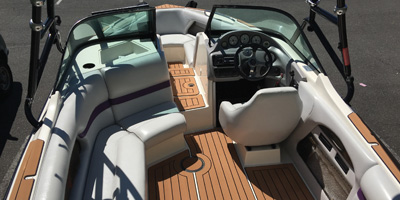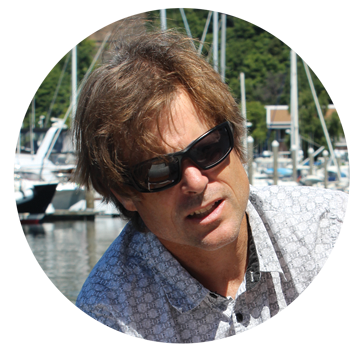“The love of beauty is taste.
The creation of beauty is art.”
—Ralph Waldo Emerson
Even a well-found vessel needs some attention to deck comfort and aesthetics. The ubiquitous cream white deck of most boats often leaves one in want, for to sit or walk barefoot on the unforgiving surface can be the very definition of uncomfortable. In many ways, the rise of adhering soft-foam panels for decks should not be a surprise to anyone. Not only do these panels tend to pop with warm colors, but most of them provide additional comfort underfoot and grip when wet. To an increasingly large number of boaters pondering soft foam paneling, the question is not “why” but “why not?”

Raptor Deck is a Seattle-based company gaining traction both locally and abroad, notably on the sailboat racing circuit. Raptor Deck soft foam, non-skid paneling makes regular appearances at the Melges 24 World Championships, as well as locally. For those familiar with the Pacific Northwest racing circuits, John Buchan’s TP52 race-winner Glory currently boasts a Raptor Deck cockpit.
I interviewed Dan Kaseler, owner and founder of Raptor Deck and an avid wind and water sports enthusiast, about Raptor Deck and soft foam, non-skid paneling in general. I caught up to him at the end of a job in Elliott Bay Marina where he was installing panels on the swim step of a Bayliner motoryacht on a warm summer day.
Q: What is unique about Raptor Deck? Explain what exactly it is and why boaters should consider it.
Raptor Deck is a unique soft foam, non-skid paneling solution, and there are several brands competing in this market space now. Everyone is after the same attributes: durability, comfort, and good traction. There are also lots of side benefits to soft foam, non-skid paneling, like insulation, noise reduction, and condensation block. With a soft deck, dropping a Leatherman is no big deal, and the overall comfort of having a bit of give to your floor is huge.
“At that time, we weren’t looking to start a business, but I had a bunch of EVA foam lying around that we had been using on windsurfing kits for foot pads. Our cockpit was super slippery when wet, so we used what we had, and thus made our first boat and public appearance at the Melges 24 Worlds in Corpus Christi in 2011. It was only a few months before we were getting requests for Melges kits from all over the world. From there, we branched out, made it a proper business, and started building kits for more or less anything that floated.”
Raptor Deck has come a long way since 2011 and is now often booked up with custom jobs of all kinds. Feel free to inquire if interested.
Raptordeck.com // 707-278-6749

To do it right, you need to focus on the foam recipe itself. These foams are normally combinations of PE (polyethylene) and EVA (ethylene vinyl acetate) resin. It’s not as easy as it looks. Pitfalls can be poor lamination, second-grade adhesive, heat shrink, UV degradation, and general durability. We’ve put a lot of effort over the last several years into making sure our customers get the best product we can deliver. We’ve done a lot of testing on-site and in the UV box at Cascade Tek to get to where we are now.
Q: Are there specific applications or types of boats that make up most of your clientele? Sport fishermen? Sailors?
Our first breakthrough was in the sailing market. We build deck kits for a lot of top racing teams from around the world. We literally ship internationally every week. Those guys really value the grip and the super lightweight aspect of what we are doing.
From there, we started picking up lots of wake-surf crew, and the medium-sized cruisers followed right afterward. From dinghies to sport fishing customers, to large carbon racing yachts, we have done it all, and the market continues to grow. I am not exactly sure where the product tops out. If you have a big, beautiful, real teak deck, by all means stick with it. That said, if you have an older gel-coated craft, or an aluminum boat, give us a ring, and we can give you a terrific upgrade.
Q: Walk us through the process, from signing the dotted line to finished product.
We work in a few different ways. The most basic level is the full DIY customer. Some people want to do it themselves, and to support that niche, we sell blank sheets and some set-step sizes which can be chopped up with a utility knife. The best place to pick these up in the Northwest is Fisheries Supply.
The next level is the customer that wants a kit, and is willing to send us a pattern, and likely do their own install. This is our biggest segment. The final group is the guys who want the full turnkey deal. For those customers, we do the patterning and the install as well.
Let’s talk about that second level, as that’s the bulk of how we operate. When these customers contact us, if we don’t have a pattern already in the database for their boat type, we instruct them briefly on how to build us a film template, or pattern of the swim step, or areas that they want to upgrade.
Once a pattern has been pulled, and we receive it at our Ballard location, we digitize the physical patterns to get the data into Rhino, our CAD (computer-aided design) software. At this point, as we know the complexity and the material usage, we can nail down the quoted price to the penny, and send a PDF proof to the end consumer. Upon approval, we fire up the CNC (computer numerical control) router, and cut the custom parts that comprise a deck kit.
Q: What’s involved in the application process, how does it work?
Everything we do is peel and stick. That’s one of the huge benefits of these systems. The smoother the surface, the better the adhesion, but with good acrylic-based PSA (pressure sensitive adhesion) from the 3M Company, it is possible to stick over some pretty aggressive existing textures.
For application, it’s a matter of dry fitting the pads, making a few true up marks, and sticking the panels down from the center towards the edges to minimize trapped air. We also advise customers to press the pads down aggressively on install to get the best bond possible. A two-inch J roller can be great for this purpose, but is not imperative.
 Dan Kaseler is the owner and founder of Raptor Deck and lifetime lover of water and wind sports. “I was quite involved in product development for boardsports markets with Naish, Gaastra, and finally Avanti. We developed a number of important innovations and products for windsurfing and helped develop and put kiteboarding on the map,” says Kaseler. “I also found myself working in the greater sailmaking markets, and larger marine business on many projects, from Quantum Sails to Velocitek. My history really revolved around product development for anything that sailed. Raptor Deck sprung from that unique background.”
Dan Kaseler is the owner and founder of Raptor Deck and lifetime lover of water and wind sports. “I was quite involved in product development for boardsports markets with Naish, Gaastra, and finally Avanti. We developed a number of important innovations and products for windsurfing and helped develop and put kiteboarding on the map,” says Kaseler. “I also found myself working in the greater sailmaking markets, and larger marine business on many projects, from Quantum Sails to Velocitek. My history really revolved around product development for anything that sailed. Raptor Deck sprung from that unique background.”Q: Is there anything a potential client can do to make a job run more smoothly?
f you make us a perfect pattern, you will get a perfect kit. It’s not hard, but taking a little extra time at the patterning step pays a huge reward in fit and finish. Get us to build you a few smaller panels to check us out. You’ll be back for more!
Q: You mentioned the Raptor “recipe.” You probably can’t give away trade secrets, but what’s special about your secret sauce?
Soft deck foam and is typically either made from PE or EVA resin. They can be one or the other, or a combination of the two. You can use UV inhibitors, and other additives to modify the characteristics. There are some variations in the process of blowing the foam that also have an effect.
I certainly can’t go into specifics. We have a few competitors out there doing a good job with their foam, whereas some are really terrible, so it’s important to do your homework as a consumer. We do a lot of testing here at Raptor, and our product shows that commitment.